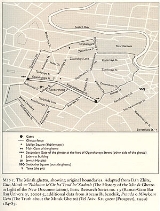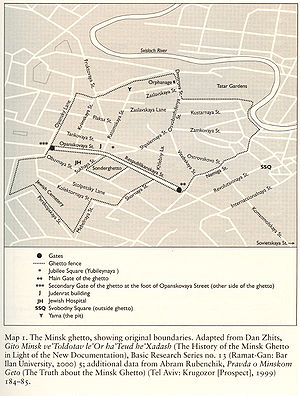
Minsk Ghetto
Encyclopedia

Eastern Europe
Eastern Europe is the eastern part of Europe. The term has widely disparate geopolitical, geographical, cultural and socioeconomic readings, which makes it highly context-dependent and even volatile, and there are "almost as many definitions of Eastern Europe as there are scholars of the region"...
, and the largest in the German-occupied territory of the Soviet Union
Soviet Union
The Soviet Union , officially the Union of Soviet Socialist Republics , was a constitutionally socialist state that existed in Eurasia between 1922 and 1991....
. It housed close to 100,000 Jews, most of whom perished in The Holocaust
The Holocaust
The Holocaust , also known as the Shoah , was the genocide of approximately six million European Jews and millions of others during World War II, a programme of systematic state-sponsored murder by Nazi...
.
History
The Soviet census of 1926 showed 53,700 Jews living in MinskMinsk
- Ecological situation :The ecological situation is monitored by Republican Center of Radioactive and Environmental Control .During 2003–2008 the overall weight of contaminants increased from 186,000 to 247,400 tons. The change of gas as industrial fuel to mazut for financial reasons has worsened...
(constituting close to 41% of the city's inhabitants).
The ghetto was created soon after the German invasion of the Soviet Union and capture of the city of Minsk
Minsk
- Ecological situation :The ecological situation is monitored by Republican Center of Radioactive and Environmental Control .During 2003–2008 the overall weight of contaminants increased from 186,000 to 247,400 tons. The change of gas as industrial fuel to mazut for financial reasons has worsened...
, capital of the Belorussian SSR, on 28 June 1941. On the fifth day after the occupation, 2,000 Jewish intelligentsia were massacred by the Germans; from then on, murders of Jews became a common occurrence. About 20,000 Jews were murdered within the first few months of the German occupation, mostly by the Einsatsgruppen squads.
On 17 July 1941 the German occupational authority, the Reichskommissariat Ostland
Reichskommissariat Ostland
Reichskommissariat Ostland, literally "Reich Commissariat Eastland", was the civilian occupation regime established by Nazi Germany in the Baltic states and much of Belarus during World War II. It was also known as Reichskommissariat Baltenland initially...
, was created. On the 20th, the Minsk Ghetto was established. A Jewish Council (Judenrat
Judenrat
Judenräte were administrative bodies during the Second World War that the Germans required Jews to form in the German occupied territory of Poland, and later in the occupied territories of the Soviet Union It is the overall term for the enforcement bodies established by the Nazi occupiers to...
) was established as well. The total population of the ghetto was about 80,000 (over 100,000 according to some sources), of which about 50,000 were pre-war inhabitants, the remainder (30,000 or more), refugees and Jews were forcibly resettled by the Germans from nearby settlements.
In November 1941 a second ghetto was established in Minsk for Jews deported from the West. They were mostly from Germany and the Protectorate of Bohemia and Moravia
Protectorate of Bohemia and Moravia
The Protectorate of Bohemia and Moravia was the majority ethnic-Czech protectorate which Nazi Germany established in the central parts of Bohemia, Moravia and Czech Silesia in what is today the Czech Republic...
; at its height it had about 35,000 inhabitants. Little contact was permitted between the inhabitants of the two ghettos.
As in many other ghettos, Jews were forced to work in factories or other German-run operations. Ghetto inhabitants lived in extremely poor conditions, with insufficient stocks of food and medical supplies.
In March 1942 approximately 5,000 Jews were killed nearby where "The Pit
The Pit (memorial)
The Pit is a monument on the corner of Melnikayte and Zaglavskaya streets devoted to the victims of the Holocaust in Minsk, Belarus. It is on the site where, on March 2, 1942, the Nazi forces shot about 5000 prisoners of the nearby Minsk Ghetto....
" memorial to the Minsk ghetto now stands. By August less than 9,000 Jews were left in the ghetto according to German official documents. The ghetto was liquidated on 21 October 1943, with many Minsk Jews perishing in the Sobibor extermination camp
Sobibór extermination camp
Sobibor was a Nazi German extermination camp located on the outskirts of the town of Sobibór, Lublin Voivodeship of occupied Poland as part of Operation Reinhard; the official German name was SS-Sonderkommando Sobibor...
. Several thousands were massacred at Maly Trostenets extermination camp
Maly Trostenets extermination camp
Maly Trastsianiets extermination camp , located near a small village on the outskirts of Minsk, Belarus, was the site of a Nazi extermination camp.- History :...
(before the war, Maly Trostenets was a village a few miles to the east of Minsk). By the time the Red Army
Red Army
The Workers' and Peasants' Red Army started out as the Soviet Union's revolutionary communist combat groups during the Russian Civil War of 1918-1922. It grew into the national army of the Soviet Union. By the 1930s the Red Army was among the largest armies in history.The "Red Army" name refers to...
retook the city on 3 July 1944, there were only a few Jewish survivors.
Resistance
The Minsk Ghetto is notable for its large scale resistance organization, which cooperated closely with Soviet partisansSoviet partisans
The Soviet partisans were members of a resistance movement which fought a guerrilla war against the Axis occupation of the Soviet Union during World War II....
. About 10,000 Jews were able to escape the ghetto and join partisan groups in the nearby forests. Barbara Epstein
Barbara Epstein
Barbara Epstein was a literary editor and a founding co-editor of the New York Review of Books.Epstein, née Zimmerman, was born in Boston, Massachusetts, United States, to a Jewish-American family, and graduated from Radcliffe College in 1949.Ms...
estimates that perhaps a half of them survived, and notes that all together, perhaps as many as 30,000 people tried to escape the Minsk Ghetto to join the partisans (but 20,000 of them could have died along the way).
Historiography
The story of the Minsk ghetto was not well researched until the late 20th century. Officials of the Belorussia communist party did not organize any evacuation of the town's inhabitants before fleeing the German advance. They later collaborated in creating a false story that such an evacuation did happen. They also tried to discredit the Minsk resistance as having ties with the Nazis. In the United States, research into communist resistance was not a priority during the Cold WarCold War
The Cold War was the continuing state from roughly 1946 to 1991 of political conflict, military tension, proxy wars, and economic competition between the Communist World—primarily the Soviet Union and its satellite states and allies—and the powers of the Western world, primarily the United States...
, and Jewish historiography did not wish to concentrate on the issue of communist Jewish partisans (see also Red scare
Red Scare
Durrell Blackwell Durrell Blackwell The term Red Scare denotes two distinct periods of strong Anti-Communism in the United States: the First Red Scare, from 1919 to 1920, and the Second Red Scare, from 1947 to 1957. The First Red Scare was about worker revolution and...
).
See also
- The Holocaust in Belarus
- Jewish ghettos of EuropeGhettos in occupied Europe 1939-1944During World War II, ghettos in Nazi-occupied Europe were set up by the Third Reich in order to confine Jews and sometimes Gypsies into tightly packed areas of the cities...
Further reading
- Barbara Epstein, The Minsk Ghetto 1941-1943: Jewish resistance and Soviet internationalism, University of California Press, 2008, ISBN 978-0-520-24242-5 (http://www.minskghetto.com/)
- Hersh Smolar, The Minsk Ghetto: Soviet-Jewish partisans against the Nazis, Holocaust Library, 1989, ISBN 0896040682
External links
- Map of the Minsk Ghetto at USHMM
- Minsk Ghetto Photographs
- 1943 Minsk Ghetto List
- Political Controversy Marks Anniversary Of Minsk Ghetto's Destruction, Radio Free Europe, October 22, 2008

